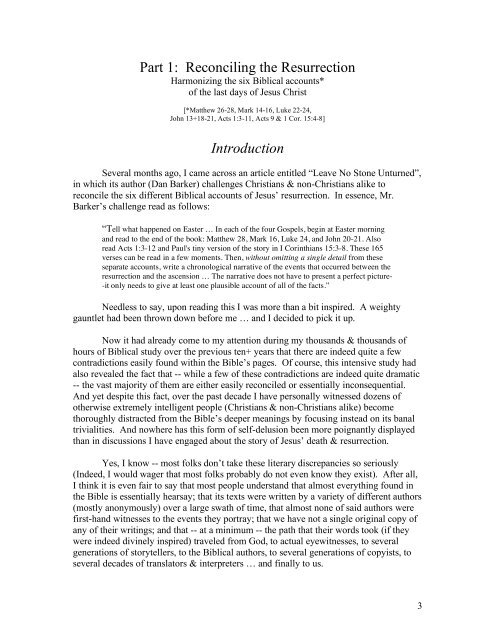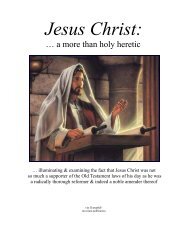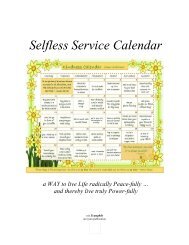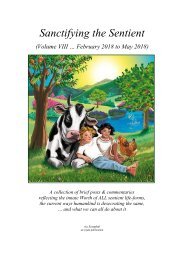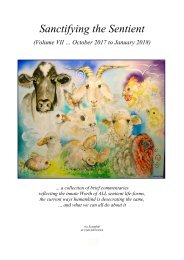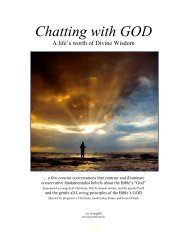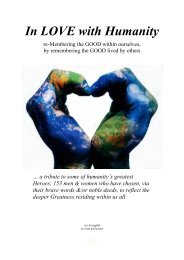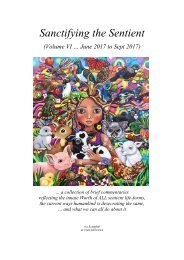Exhuming Easter (complete - 3rd edition)
Harmonizing the six Biblical accounts of the last days of Jesus Christ, and reinterpreting the implications of the same
Harmonizing the six Biblical accounts
of the last days of Jesus Christ, and reinterpreting the implications of the same
Create successful ePaper yourself
Turn your PDF publications into a flip-book with our unique Google optimized e-Paper software.
Part 1: Reconciling the Resurrection<br />
Harmonizing the six Biblical accounts*<br />
of the last days of Jesus Christ<br />
[*Matthew 26-28, Mark 14-16, Luke 22-24,<br />
John 13+18-21, Acts 1:3-11, Acts 9 & 1 Cor. 15:4-8]<br />
Introduction<br />
Several months ago, I came across an article entitled “Leave No Stone Unturned”,<br />
in which its author (Dan Barker) challenges Christians & non-Christians alike to<br />
reconcile the six different Biblical accounts of Jesus’ resurrection. In essence, Mr.<br />
Barker’s challenge read as follows:<br />
“Tell what happened on <strong>Easter</strong> … In each of the four Gospels, begin at <strong>Easter</strong> morning<br />
and read to the end of the book: Matthew 28, Mark 16, Luke 24, and John 20-21. Also<br />
read Acts 1:3-12 and Paul's tiny version of the story in I Corinthians 15:3-8. These 165<br />
verses can be read in a few moments. Then, without omitting a single detail from these<br />
separate accounts, write a chronological narrative of the events that occurred between the<br />
resurrection and the ascension … The narrative does not have to present a perfect picture-<br />
-it only needs to give at least one plausible account of all of the facts.”<br />
Needless to say, upon reading this I was more than a bit inspired. A weighty<br />
gauntlet had been thrown down before me … and I decided to pick it up.<br />
Now it had already come to my attention during my thousands & thousands of<br />
hours of Biblical study over the previous ten+ years that there are indeed quite a few<br />
contradictions easily found within the Bible’s pages. Of course, this intensive study had<br />
also revealed the fact that -- while a few of these contradictions are indeed quite dramatic<br />
-- the vast majority of them are either easily reconciled or essentially inconsequential.<br />
And yet despite this fact, over the past decade I have personally witnessed dozens of<br />
otherwise extremely intelligent people (Christians & non-Christians alike) become<br />
thoroughly distracted from the Bible’s deeper meanings by focusing instead on its banal<br />
trivialities. And nowhere has this form of self-delusion been more poignantly displayed<br />
than in discussions I have engaged about the story of Jesus’ death & resurrection.<br />
Yes, I know -- most folks don’t take these literary discrepancies so seriously<br />
(Indeed, I would wager that most folks probably do not even know they exist). After all,<br />
I think it is even fair to say that most people understand that almost everything found in<br />
the Bible is essentially hearsay; that its texts were written by a variety of different authors<br />
(mostly anonymously) over a large swath of time, that almost none of said authors were<br />
first-hand witnesses to the events they portray; that we have not a single original copy of<br />
any of their writings; and that -- at a minimum -- the path that their words took (if they<br />
were indeed divinely inspired) traveled from God, to actual eyewitnesses, to several<br />
generations of storytellers, to the Biblical authors, to several generations of copyists, to<br />
several decades of translators & interpreters … and finally to us.<br />
3


